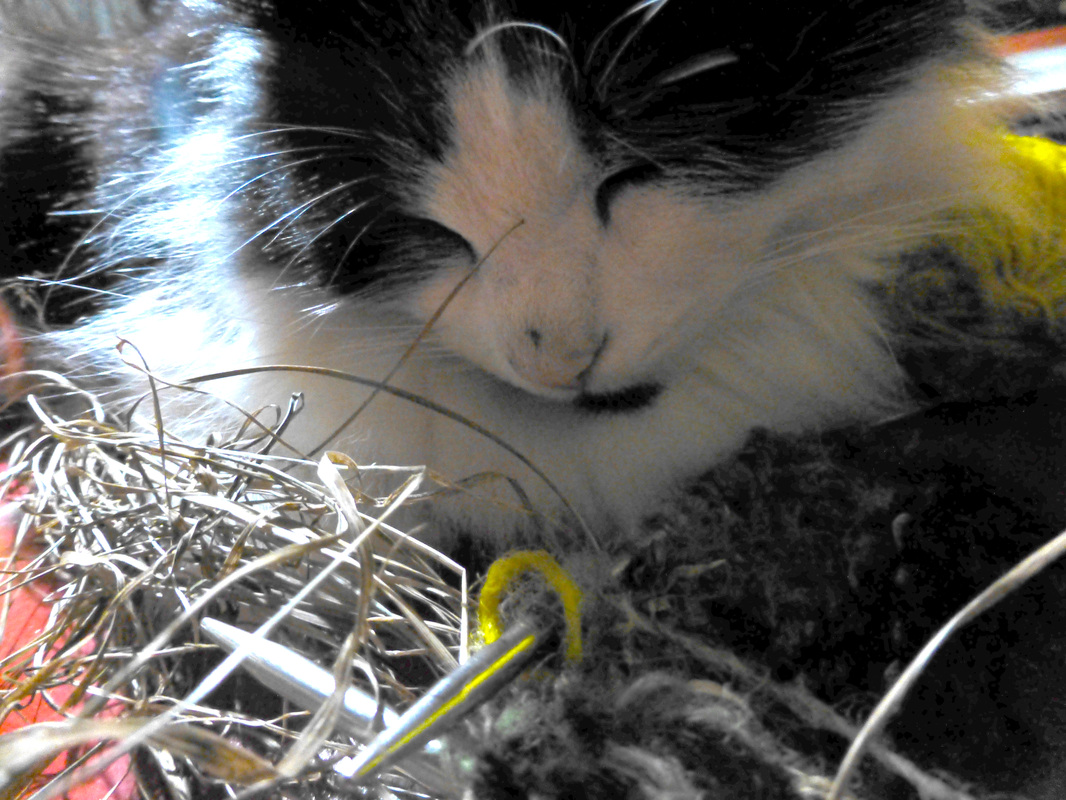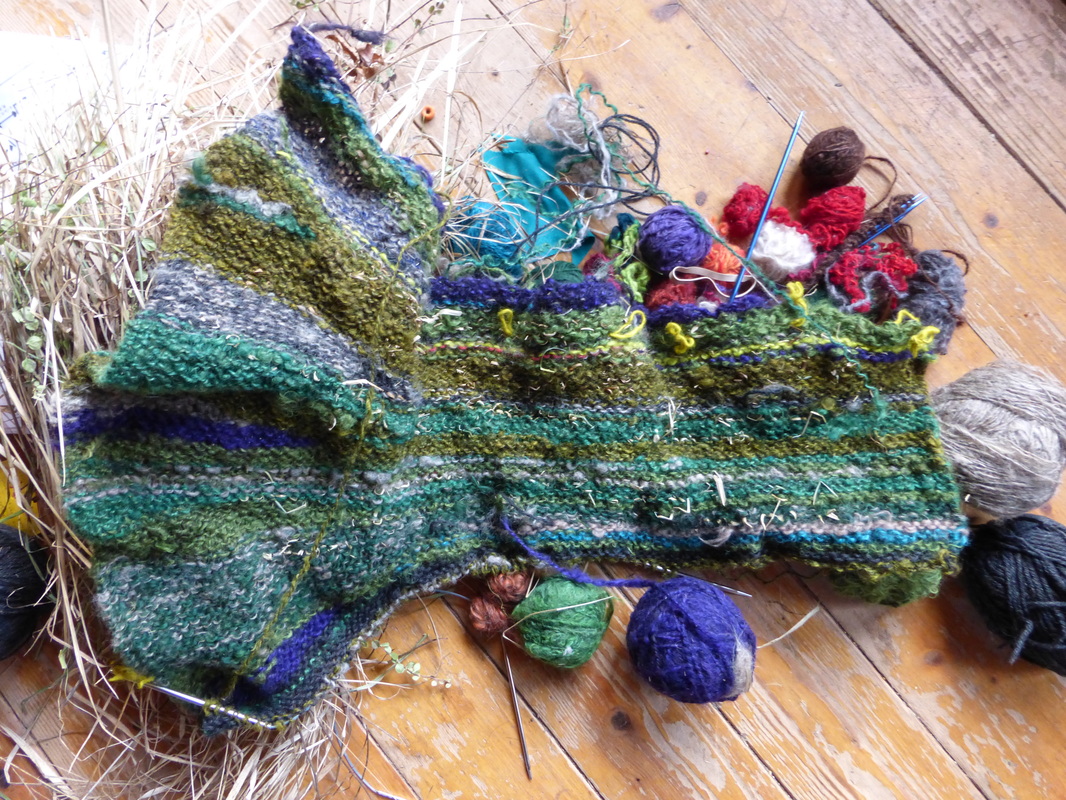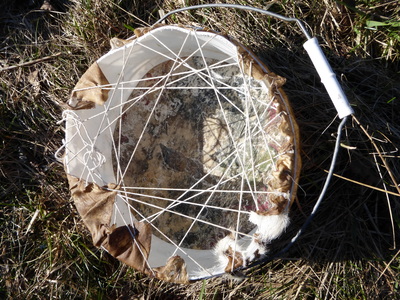The Benedicktbeueren is an ancient Bavarian monastary, famous for a collection of Medieval drinking songs, the Carmina Burana, which were discovered in it in 1803. Carl Orff set some to music. I looked up the poem O Fortuna, and found it pretty much as Carl Orff says. Then I suddenly woke up! Rabbit hole alert! Back to copying Irene Wellington! I did a rough draft and a second draft, which is probably the final draft.
|
I've been paging through More Than Fine Writing about Irene Wellington, a British calligrapher. She did a series of "panels for the staff-room at Edinburgh College of Art for firewatchers during the war" in 1943. I was struck by a fragment labeled "MS of Benedictbeuern," and looked it up. The Benedicktbeueren is an ancient Bavarian monastary, famous for a collection of Medieval drinking songs, the Carmina Burana, which were discovered in it in 1803. Carl Orff set some to music. I looked up the poem O Fortuna, and found it pretty much as Carl Orff says. Then I suddenly woke up! Rabbit hole alert! Back to copying Irene Wellington! I did a rough draft and a second draft, which is probably the final draft.
2 Comments
My grandfather was a Miro fan. I'm (slowly) putting together a website on my grandfather's life as an art teacher, struggling to translate German documents and to understand the flavor of the times he lived in.
Miro, unlike my grandfather, found a way to let his disapproval of the Franco regime come out in his art. To an American, raised in the relative freedom of the First Amendment, some of his statements seem rather obscure. For example, after Franco co-opted Miro's art to seem like an expression of not only being Spanish but being pro-Franco, Miro protested by painting a mural on the outside of the art college, then washing it off. Oh, snap! My son and I wandered through the exhibit at SAM, enjoying the serendipity of finding Miro's blurry blue spots repeated in a Japanese fan in a nearby room, and admiring the calligraphy of accidental motifs. It does seem clear, though, that modernism has said what it has said and it is time to move on. A big difference between me and Miro (aside from international renown, of course) is that I am interested in the messiness of life, in clutter, ambiguity, and the femininity of death. There is too much that I want to capture to do art that reduces all to a series of iconic motifs. I have run out of most of the little balls of yarn that I've been using for Baba Yaga's robe (though the moth-eaten sweater is still going strong). I remembered that I had an unwelcome delivery last summer, of a boxful of wool hats that didn't sell. I sold about half of them at various craft fairs, but the remainder's been in that box, until now.
They are partially felted, but with some judicious yanking the yarn mostly unravels. So, the ceremonial robe is growing as those poor old hats are being cannibalized. You can see a heathery-turquoise cable knit thing at the top of the picture, which is re-forming on the needle. Plus, after a week indoors, the beargrass is getting brittle. I tried soaking hanks of it and they soften right up, so yay, the robe continues to get its share of plant matter. Obviously, Baba Yaga is not going to use paper cards when there are dead animals lying around for making hide cards with. I cut some of the rotting hides into four-inch squares. They dried in various shapes, since I didn't use stretchers and since each section of the hide is a different thickness. As preparation for making her card deck, I visited online divination sites and asked, "How can I become a better artist?" My relation to the occult is as a skeptic. Despite not "believing" that the divination methods are speaking personally to me, and further, despite not believing that the universe aligns in a way that speaks to me, I DO believe, quite strongly, that my brain is a pattern-making device. It will find patterns in just about anything. As soon as divination results are given to me, I will begin storytelling. Since the raw materials of storytelling in my mind are unique to me, I will tell a story that is meaningful to me. Here is a demonstration of that: Using the i Ching, the answer was 60, or "One who is all over the map is no less lost than one without a map." Using the Tarot, the answer was Past: Six of Swords (I was a protector and made a tactical retreat) / Present: The Emperor (to gain control, I must take responsibility and use logic to review and plan a strategy) / Future: Four of Swords (Another retreat is in order, but since the Six of Swords was also drawn, there might be an actual journey that will bring peace of mind). Using rune sticks, the answer was Present: Laguz-fertility / Azsuz-spiritual connection to the universe, reason / Strengths: Sowilo-power and strength / Past: Uruz-discord and dissociation from power / Future: Isa-stagnation / Final Outcome: Jera-positive cycles, harvest. Using geomancy, the answer was: judge: Coniunctio-fertility / Witness #1-Cauda draconis-bad luck / Witness #2-Laetitia-joy Since I have a good judge and one bad and one good witness, the outcome depends on how I work the situation, instead of being certainly good or certainly bad. All right. The story I now tell myself about these four diviniations is that I was obstructed from being a good artist in the past, but at present I am artistically fertile (though perhaps TOO fertile, being all over the map). This is best taken advantage of by crafting a logical plan that includes my strengths. I should listen to my connection with the universe. I should expect a period of bad luck and stagnation, but in the end, there will be joy and harvest. Now, my question is, how would I form a set of divination devices that might work for Baba Yaga? They should be based on plants and animals, and they should include both birth and death. Since she is an old lady (a very old one!), wisdom, maturity, and decay should be emphasized over friskiness, charm, or physical power. I decided on groupings of four, since there are four seasons in a year. The first one includes 1. Crow Eggs, 2. Standing Crow, 3. Flying Crow, 4. Crow Skull. Perhaps in the future I'll work out a set of meanings for these, but for now, the cards themselves will be the meaning. The second grouping of four is 1. Tent Caterpillar larvae, 2 Tent caterpillar moth, 3. Tachinid Pupa, and 4. Tachinid Fly. The tent caterpillars come in swarms, and are predated on by tachinids, which lay eggs on the caterpillars' heads. I'm pretty sure they hatch inside the pupas, where they eat their hosts, and then the pupa is formed inside the host pupa.
About 20 years ago I went to Norway to visit a dear friend. My husband David asked me to get him a Norwegian “lice” sweater, and he described it exactly. Astri and I went to street booths, high-end outfitters, and flea markets but his sweater was not to be found. So, we went to a yarn shop and got the material to knit one. I worked and worked on that thing, and by the time I flew home, the body was finished, but not the sleeves. David looked at it and shook his head. “That’s not really right,” he said. “No way would I wear it. But thanks.” All right then. It was a fun adventure so I didn’t begrudge the time spent. Years passed. Now and then, I’d take the unfinished project out and knit a few rounds. A friend offered to help me figure out how to set the sleeves in. More years passed. One day, I took it out of the basket and found moth holes in it. My friend said, “Throw it out.” I couldn’t. I washed it, needles and all, and put it back in the basket. Years passed. I have a small side business of spinning wool from my sheep and selling the skeins. Somehow, there was always a short-weight ball of yarn left over at the end. They went in the basket too. A rather filthy cat nested in the basket, on top of the Norwegian sweater project and the short balls of homespun. My friend said, “Throw them out.” I couldn’t. The cat died but another one took its place. David moved away and I cleaned house top to bottom and threw away truckloads of our former life. The basket stayed. I spend a lot of time wandering around under trees and pushing my way through undergrowth. I spend a lot of time picking debris out of my clothing. Baba Yaga, though, would not do that. She would have a Good Girl do it, and, if she didn't have one of those handy, she would wear the debris. I collected some blackberry vines to knit into the robe, but decided it's too extreme, this time of year, to wrestle with spines and bloody hands and such. Cedar strips and nettles would be okay, but they're not in season yet. So, beargrass. No sooner had I started than the cat colonized my work. The project is time-consuming and fascinating. A ceremonial robe should be festive, and a recycled robe should use only unsaleable yarn, and the Friday deadline for this project requires that it be knit lickety-split. I learned how to wrap and turn for short rows and went for it. By the end of fiddle night, I had a front panel.
My neighbor Fred and I demolished a half-century-old rabbit house a few months ago. I salvaged some of the boards for some wabi-sabi building projects I wanted to do in my house. "If you are attracted to things soaked in rabbit pee, then perhaps you would like these moldy suitcases?" Fred asked solicitously, dragging them out from under a pile of really, really old hay. They were indeed moldy. I can't figure out how to open the leather one. I soaked them with high-surfactant cleaners, taking care to put the waste water into the garden where the potentially harmful surfactants would be biodegraded quickly. I decided the nylon liner was just too awful. Underneath, there was some kind of fluffy padding, which I scraped off and threw out, to reveal buckled plywood panels. Cool! But Baba Yaga, while she would certainly carry around a battered up suitcase, would want to over-decorate it with doilies and other old lady stuff. I imagine that here, in the New World, she would want to open her suitcase and find the forest in it (and not, for example, an elderly black cat. Just as an example). I have a stack of empty feedsacks. My land is too small to entirely support my two sheep and six ducks through the off-season, so I supplement their grazing with 50 lb sacks of alfalfa and corn. I give most of the empties to a lady at the District Office who makes carry totes from them, but reserved some of them and gessoed their backs. Next, to paint a forest scene on a feedsack. I am trying to decide whether to put the doilies on the bottom or on the lid of the suitcase. The forest scene will go on the other piece.
Baba Yaga is an archetype that fascinates me, she and her sisters Mother Holle and that Northwest Indian Cannibal Basket Woman. They are forest forces, who eat badly behaved children and reward the good ones. Our definitions of "good" and "bad" have changed a little bit. Obedience is not as greatly valued as it used to be, but kindness and a willingness to work hard still sound pretty good. In my imagination, though, these ladies take on the role of Nature goddesses. Like nature, they are deadly and implacable. They eat you. And like nature, they have their charming side. I'm working on a set of pieces for a recycled art show in Bellingham. Since I live on an island I'm forced to think about my waste stream, and so I have far less trash to work with than my mainland peers, who can probably find everything they need in a single afternoon of dumpster diving. Instead, I looked at the trash that's available to me here in this rural area. Firstly, there is offal. My neighbor slaughtered 16 lambs, as he does every year before the lean months of winter. I have some meat in my freezer. On one of my beach walks, I found where he had dumped the hides and offal for the eagles. In an act of kleptoparasitism, I took some of the hides home, shedding sand, rotting fat, and fleece as I went. I had this idea that I'd prepare the hides to make vellum. It's a labor intensive, stinky job that I spent a few afternoons on but then somehow never got back to. Some of the hides rotted past use, none of them lost all their fur, and in the cold of winter I finally steeled myself to return to the project. I ran some hides through the washing machine and picked off as much of the fat as I could stand to work on, thinking about what the Baba Yaga project was going to include. In the mean time, I had a pile of trash that was created in the last freeze, including some plastic restaurant buckets that were under the gutter drain and buckled as the water froze. Perfect. I'll make a drum for the lady using an undamaged part of a bucket. The biggest piece of the hide I chose for the drum still had a bit of hair on it, and some holes where the skin was starting to rot. Baba Yaga's symbols include the chicken-footed house, and her mortar and pestle that she travels with, and the bones that her fence is made of. Those didn't seem right for the painting on the drum. Then I noticed a raven sitting in my garden, staring at one of the lamb heads that is rotting there. Okay then. Ravens.
I like the idea of mandalas, especially when dealing with nature goddesses, who embody the cycle of the year. The design of this drum includes the nest with eggs for the beginning, and a raven skull for the ending, and then two ravens looking either protective or menacing, depending on whether you are a good or a bad person. |
|






















 RSS Feed
RSS Feed
